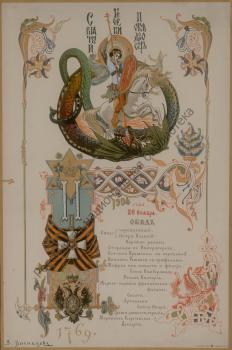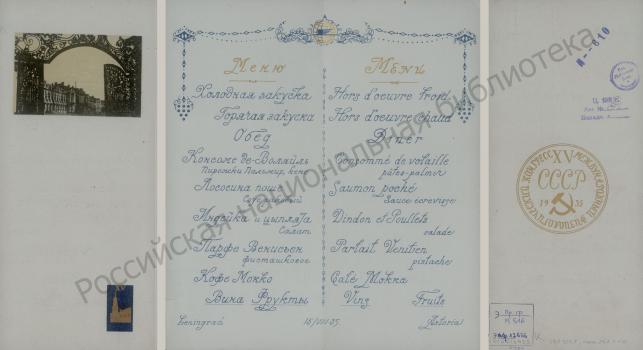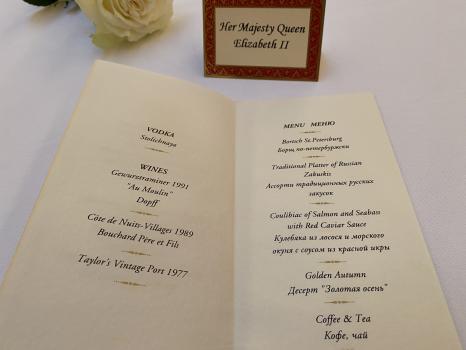Petersburg Cuisine in the 19th-21st Century Сoronation and Solemn Menus of Lunches and Dinners
Petersburg Cuisine
Expert of Petersburg Cuisine Project Tatyana Tsvetkova
In Russia, detailed information about dishes of wedding feasts has been preserved since the reign of Alexis of Russia. The history of Petersburg cooking started in the 18th century. That's when French, English and German dishes were served at coronation ceremonies and court holidays in the Imperial palaces, along with traditional Russian dishes. Dishes began to shape into a cuisine based on Russian (local) products and French cooking techniques.
This occured with the relocation of the capital to St. Petersburg where European chefs he joined the Russian staff in the palaces of the capital's nobility.
The fashion for ceremonial menus come from Paris to St. Petersburg in the 19th century. Famous artists of various art schools considered it an honor to draw menus for Imperial coronation celebrations, ceremonial banquets and dinners. Among them are mostly recognized masters of the Russian style Viktor and Apollinary Vasnetsov, Alexander Benois, Ivan Petrov-Ropet, Ernst Lipgart. Their works not only left a memory of such events, but are real masterpieces. At the Imperial Court, there was an old tradition of signing them by participants of the feast. Such menus were carefully kept as a reminder of a pleasant evening. Sometimes the menu card was even framed and hung on the wall, along with photographs of loved ones. So it was in the Gatchina Palace: similar menus hung in frames in the rooms of Alexander III.Historical menus from the collection of the National Library of Russia allow us to trace the evolution of St. Petersburg cuisine in different times of the reigns of Russian emperors, using archival materials. The coronation menus evidence about the triumph of Petersburg cuisine that combines Russian culinary traditions (crayfish soup, borscht, kulebyaka, sterlet, Guryev porridge) and European (French, English) cooking techniques (turtle soup, puree soup, aspic, marechal, pudding, soufflé).
In the USSR, gastronomic delights were not welcomed. The focus was not on taste, but on the nutritional profiles of products, their calorie content.
However, we have menus that tell us about the revival of haute cuisine traditions in the new state. Dishes of high Petersburg cuisine (consommé, salmon with crayfish sauce, parfait) were served at the Astoria Hotel at the banquet of the International Congress of Physiologists in Leningrad in 1935. As conceived by the organizers, they helped to create a good image of the new government among foreign guests. Even in the most difficult years of the war, diplomatic receptions were given in the Kremlin.The most famous diplomatic reception was the Yalta Conference (February 1945), which, as you know, was won by Stalin. This happened largely due to the excellent cuisine that reigned throughout the days of that historic meeting. It is important to note that dishes of Russian and French, i.e. Petersburg cuisine were served on the tables. These dishes are well known to us: puréed poulard soup, borscht, consommé with profiteroles, sterlet in champagne, roast game (grouse, partridge, black grouse). Russian snacks (red caviar, salted and smoked fish) increased the effect of hospitality. For dessert, chocolate parfait, macedouin were offered, as well as petit fours, fruit, roasted almonds and much more. The traditions of St. Petersburg cuisine with exquisite dishes, Russian serving at the highest level receptions remained throughout the Soviet period.
During the visit of the Queen of Great Britain to St. Petersburg in 1994, when compiling the lunch menu, it was necessary to include the best dishes of Russian cuisine, which would open Petersburg for Elizabeth II from a new side. The introductory part of the dinner was St. Petersburg-style borscht with smoked ribs. Starters included aspic and sturgeon, and the main course was salmon and sea bass kulebyaka with red caviar sauce. For dessert, a special treat was created — dessert "Golden Autumn" — marzipan apple stuffed with apple mousse. All these dishes have preserved the traditions of high Petersburg cuisine.Careful study of historical menus, as well as the 19th century cookbooks, helps to preserve, revive and develop the traditions of St. Petersburg cuisine already in the 21st century.
References:
- Zakharova O. Yu. Rossiyskoye tseremonial'noye zastol'ye : starinnyye menyu i retsepty imperatorskoy kukhni Livadiyskogo dvortsa (Russian Ceremonial Feast: Old Menus and Recipes of the Imperial Cuisine of the Livadia Palace) / Oksana Zakharova, Sergey Pushkarev. – Moscow: Tsentrpoligraf, 2012. – 189 pp., [12] sh. col. ill. : ill. – Bibliography: p. 188
Shelfmark: 2012-7/4706 - Zimin I. V. Tsarskaya rabota, XIX – nachalo XX v : povsednevnaya zhizn' Rossiyskogo imperatorskogo dvora (Royal Work, 19th – early 20th century: daily life of the Russian Imperial court) / Igor Zimin. – Moscow: Tsentrpoligraf; St. Petersburg: Russian Troika-SPb, 2011. – 638, [1] p. : ill., portr. – Bibliography: pp. 631-636 and in the note: pp. 571-616
Shelfmark: С1 Т3(2)5/З-622, 2011-3/23375, У Т3(2)5-7/З-622 - Chapkina M.Ya. Russkiy modern i paradnyye menyu. (Russian Modern and Ceremonial Menus). [Electronic resource]. – URL: http://www.raruss.ru/russe-moderne/moderne2/3841 (Accessed: 08.12.2022)


